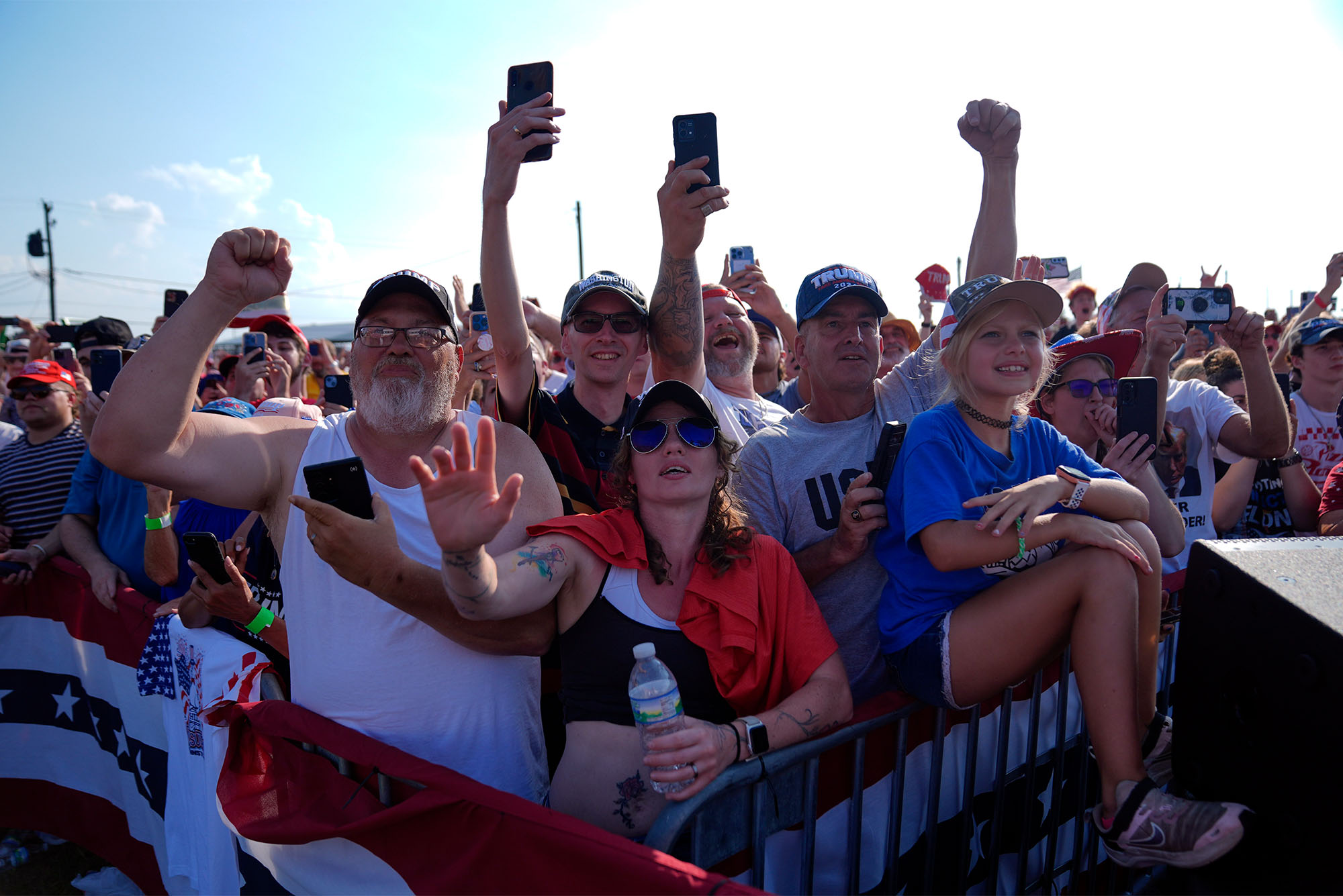Conspiracy Theories Swirled after the Assassination Attempt on Donald Trump—Here’s Why
It’s natural to want to fill in gaps in information, says BU political communications expert Chris Wells, but the wild theories aren’t likely swaying voters

Almost immediately after the attempted assassination of Donald Trump, conspiracy theories, memes, and misinformation swirled online—but it’s driven by a small group of highly active political news consumers, creating an echochamber that likely won’t reverberate much further into the general voting public, says a BU political communications expert. AP Photo/Evan Vucci
Conspiracy Theories Swirled after the Assassination Attempt on Donald Trump—Here’s Why
It’s natural to want to fill in gaps in information, says BU political communications expert Chris Wells, but the wild theories aren’t likely swaying voters
Within minutes of the attempted assassination of former president Donald Trump at a rally in Pennsylvania last Saturday, the internet was alight with jokey memes, convoluted conspiracy theories, and a swirl of misinformation.
But we’ve seen this before, says Chris Wells, an associate professor of emerging media studies at Boston University’s College of Communications.
The stakes may seem higher—this was the first assassination attempt to happen in this real-time information era—but the immediate reaction online was not unlike other mass shootings or crises of similar scale.
“In these kinds of crisis moments, you see this eruption of a whole bunch of conspiracy theories,” says Wells, who studies political communication and how citizens learn about politics. “We saw this with the Boston Marathon bombing [in 2014], where online sleuths were hopped up with these theories and ultimately misidentified three people that they said were responsible for it before police actually sorted it out.”
It’s natural to want to fill in gaps in information, especially after a shocking event where little is immediately known or verifiable, Wells says. Such was the case with the chaotic events at Saturday’s rally. Several days later, we know that federal law officials have identified 20-year-old Thomas Crooks as the shooter. Secret Service agents have said that Crooks fired multiple shots with an AR-15-style rifle, killing one rally-goer and critically injuring two others before being killed by a Secret Service agent.
But, big questions remain unanswered: Why did Crooks fire at Trump? What security lapses allowed him to gain access to a clear vantage point? An investigation of this size, with the stakes this high, will take months—maybe years. In the meantime, people may speculate wildly online, or assign blame in a politically convenient way.
Almost immediately after the attempted assassination, some right-wing hardliners took to social media to falsely blame President Joe Biden for the attack. Others claimed the whole scene was staged, also false. By and large, Wells says, it’s a handful of highly active people online making these claims—and it’s not clear whether their message is reaching a particularly large audience or convincing anyone with their theories.
“Most of this happens within a very small, but very active group of people who follow political news all the time, and are already very committed, politically,” he says, adding that most people likely have a broad awareness of the political climate, but aren’t following every breathless update the way journalists have to, or that highly politically active citizens do.
Most of this happens within a very small, but very active group of people who follow political news all the time, and are already very committed, politically.
“One of our challenges in political communication is trying to measure what sort of refraction of political events are actually making it to people,” Wells says. “And in that sense, what we do know is that it’s a relatively small number of people who are actually going to go out and make a new conspiracy theory about something. This is a vanishingly small proportion of the electorate. I mean, the proportion of the electorate that would ever even go to a political rally is less than 1 percent or something. So we’re talking about a very small group of people.”
But in those small communities, memes and conspiracy theories can spread like wildfire, circulating on people’s newsfeeds, but not making it much further afield, such that it creates a sort of echo chamber.
For Wells and other political communications researchers, the bigger question is: how much will an event such as this shape the broader public view of the presidential race?
“The event itself I think is likely to have some effect,” he says. “I suspect it might be very small, in terms of making Trump more relatable as somebody who has been the victim of violence. We’ve seen that the image of him with his fist raised has already circulated widely, and I suspect that that will be more influential on people who are predisposed to Trump, whereas others will see it as sort of a crazy image. But I’m not sure that the conspiracy theories will have any greater impact than they do with a lot of these cases in terms of shaping public opinion.”
After all, in a contest between two known entities in a highly polarized political climate, most voters have already made up their mind about who they’ll choose on November 3.
“I think that most people who are anywhere near the political system have an established viewpoint already,” Wells says, “and they’re likely to accept conspiracy theories that are in line with that viewpoint, rather than having the viewpoint changed by exposure to conspiracy theories.
“Everything that I’m seeing in this election suggests that it’s people who are very marginally attuned to what’s going on politically who will likely make up the difference in the key states. And so the key question is: what sort of impression of the event are they getting?”
Wells says he’ll be paying close attention to how the topic of political violence is discussed in the coming days and weeks, especially by “political elites” at the top of their respective parties. Already, Biden has asked Americans to reject political violence and “cool down” the temperature in a heated race. And Republicans at this week’s Republican National Convention have largely framed Trump’s survival as a sign of divine intervention.
In the meantime, it’s unlikely that the real-time speculation by online observers is doing much to help matters.
“The primary characteristic of crisis [communications] is the level of uncertainty. And in this case, there’s uncertainty for the people who really have all the available information—the FBI is dealing with a lot of uncertainty that they’re trying to sort out,” Wells says.
So for online commenters, who are multiple steps removed from that information, he says, “I’m not sure what the value is, from a democratic standpoint, of people being able to wildly speculate publicly about what might or might not have happened.”

Comments & Discussion
Boston University moderates comments to facilitate an informed, substantive, civil conversation. Abusive, profane, self-promotional, misleading, incoherent or off-topic comments will be rejected. Moderators are staffed during regular business hours (EST) and can only accept comments written in English. Statistics or facts must include a citation or a link to the citation.